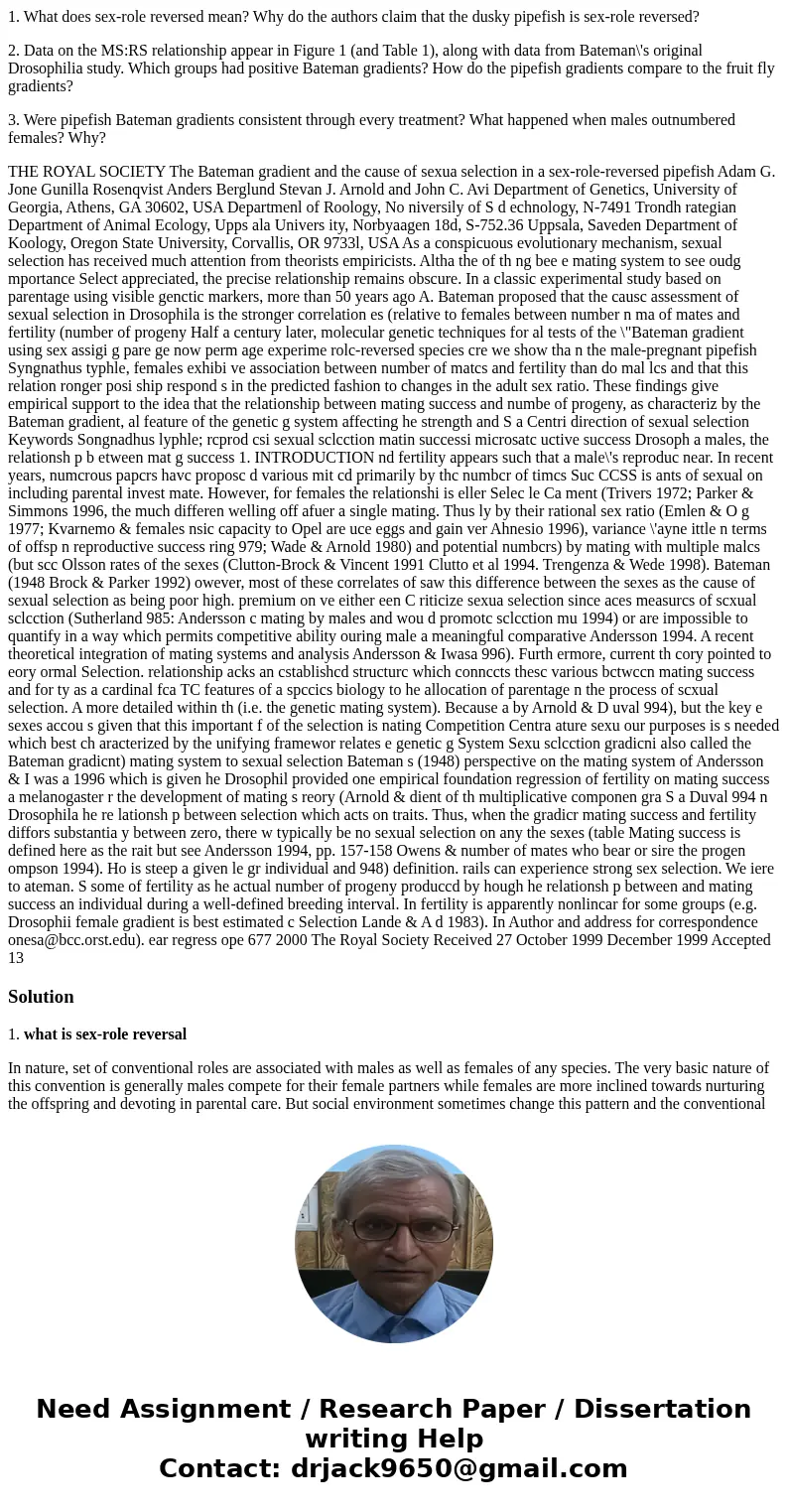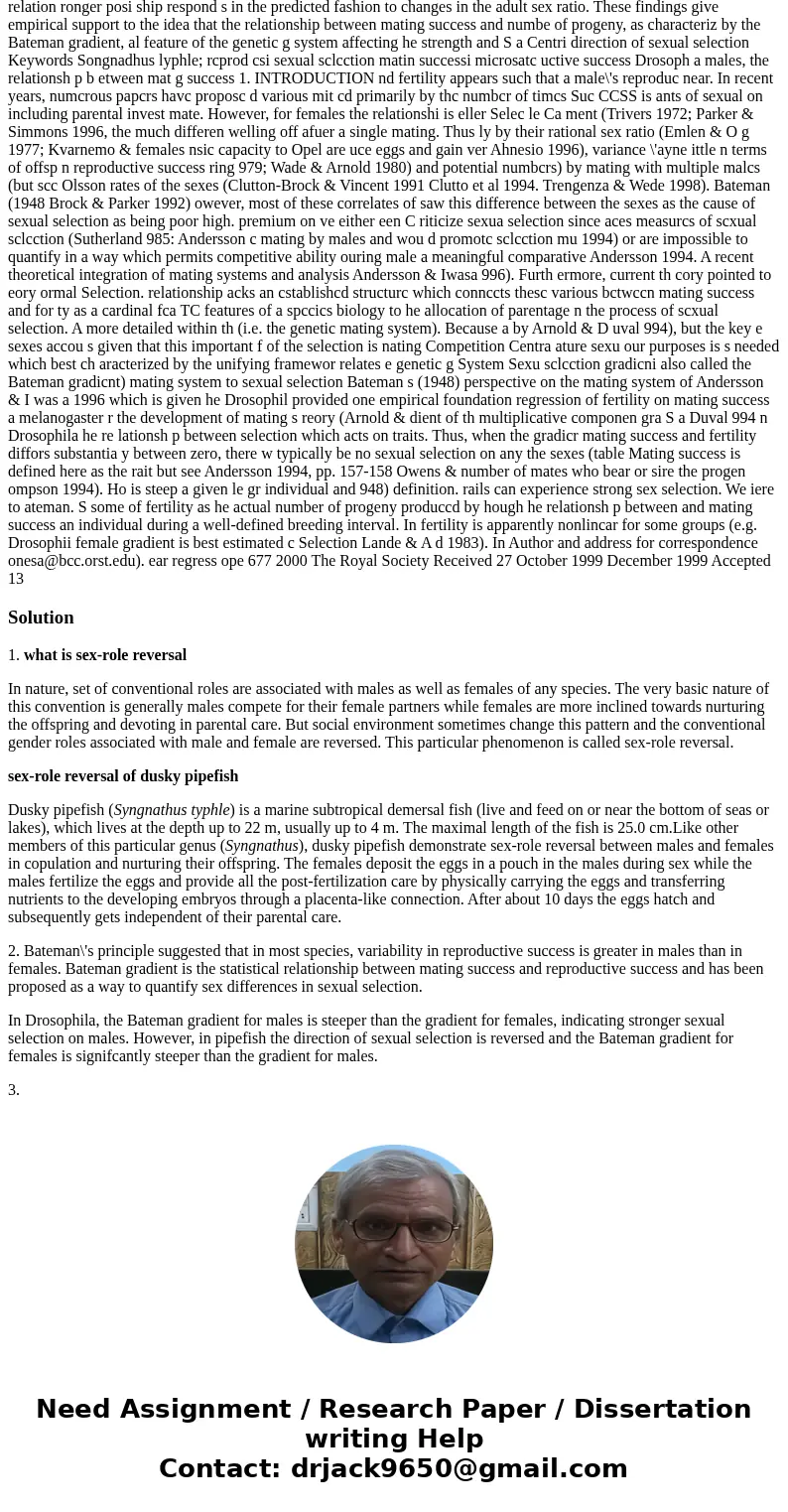1 What does sexrole reversed mean Why do the authors claim t
1. What does sex-role reversed mean? Why do the authors claim that the dusky pipefish is sex-role reversed?
2. Data on the MS:RS relationship appear in Figure 1 (and Table 1), along with data from Bateman\'s original Drosophilia study. Which groups had positive Bateman gradients? How do the pipefish gradients compare to the fruit fly gradients?
3. Were pipefish Bateman gradients consistent through every treatment? What happened when males outnumbered females? Why?
THE ROYAL SOCIETY The Bateman gradient and the cause of sexua selection in a sex-role-reversed pipefish Adam G. Jone Gunilla Rosenqvist Anders Berglund Stevan J. Arnold and John C. Avi Department of Genetics, University of Georgia, Athens, GA 30602, USA Departmenl of Roology, No niversily of S d echnology, N-7491 Trondh rategian Department of Animal Ecology, Upps ala Univers ity, Norbyaagen 18d, S-752.36 Uppsala, Saveden Department of Koology, Oregon State University, Corvallis, OR 9733l, USA As a conspicuous evolutionary mechanism, sexual selection has received much attention from theorists empiricists. Altha the of th ng bee e mating system to see oudg mportance Select appreciated, the precise relationship remains obscure. In a classic experimental study based on parentage using visible genctic markers, more than 50 years ago A. Bateman proposed that the causc assessment of sexual selection in Drosophila is the stronger correlation es (relative to females between number n ma of mates and fertility (number of progeny Half a century later, molecular genetic techniques for al tests of the \"Bateman gradient using sex assigi g pare ge now perm age experime rolc-reversed species cre we show tha n the male-pregnant pipefish Syngnathus typhle, females exhibi ve association between number of matcs and fertility than do mal lcs and that this relation ronger posi ship respond s in the predicted fashion to changes in the adult sex ratio. These findings give empirical support to the idea that the relationship between mating success and numbe of progeny, as characteriz by the Bateman gradient, al feature of the genetic g system affecting he strength and S a Centri direction of sexual selection Keywords Songnadhus lyphle; rcprod csi sexual sclcction matin successi microsatc uctive success Drosoph a males, the relationsh p b etween mat g success 1. INTRODUCTION nd fertility appears such that a male\'s reproduc near. In recent years, numcrous papcrs havc proposc d various mit cd primarily by thc numbcr of timcs Suc CCSS is ants of sexual on including parental invest mate. However, for females the relationshi is eller Selec le Ca ment (Trivers 1972; Parker & Simmons 1996, the much differen welling off afuer a single mating. Thus ly by their rational sex ratio (Emlen & O g 1977; Kvarnemo & females nsic capacity to Opel are uce eggs and gain ver Ahnesio 1996), variance \'ayne ittle n terms of offsp n reproductive success ring 979; Wade & Arnold 1980) and potential numbcrs) by mating with multiple malcs (but scc Olsson rates of the sexes (Clutton-Brock & Vincent 1991 Clutto et al 1994. Trengenza & Wede 1998). Bateman (1948 Brock & Parker 1992) owever, most of these correlates of saw this difference between the sexes as the cause of sexual selection as being poor high. premium on ve either een C riticize sexua selection since aces measurcs of scxual sclcction (Sutherland 985: Andersson c mating by males and wou d promotc sclcction mu 1994) or are impossible to quantify in a way which permits competitive ability ouring male a meaningful comparative Andersson 1994. A recent theoretical integration of mating systems and analysis Andersson & Iwasa 996). Furth ermore, current th cory pointed to eory ormal Selection. relationship acks an cstablishcd structurc which connccts thesc various bctwccn mating success and for ty as a cardinal fca TC features of a spccics biology to he allocation of parentage n the process of scxual selection. A more detailed within th (i.e. the genetic mating system). Because a by Arnold & D uval 994), but the key e sexes accou s given that this important f of the selection is nating Competition Centra ature sexu our purposes is s needed which best ch aracterized by the unifying framewor relates e genetic g System Sexu sclcction gradicni also called the Bateman gradicnt) mating system to sexual selection Bateman s (1948) perspective on the mating system of Andersson & I was a 1996 which is given he Drosophil provided one empirical foundation regression of fertility on mating success a melanogaster r the development of mating s reory (Arnold & dient of th multiplicative componen gra S a Duval 994 n Drosophila he re lationsh p between selection which acts on traits. Thus, when the gradicr mating success and fertility diffors substantia y between zero, there w typically be no sexual selection on any the sexes (table Mating success is defined here as the rait but see Andersson 1994, pp. 157-158 Owens & number of mates who bear or sire the progen ompson 1994). Ho is steep a given le gr individual and 948) definition. rails can experience strong sex selection. We iere to ateman. S some of fertility as he actual number of progeny produccd by hough he relationsh p between and mating success an individual during a well-defined breeding interval. In fertility is apparently nonlincar for some groups (e.g. Drosophii female gradient is best estimated c Selection Lande & A d 1983). In Author and address for correspondence onesa@bcc.orst.edu). ear regress ope 677 2000 The Royal Society Received 27 October 1999 December 1999 Accepted 13Solution
1. what is sex-role reversal
In nature, set of conventional roles are associated with males as well as females of any species. The very basic nature of this convention is generally males compete for their female partners while females are more inclined towards nurturing the offspring and devoting in parental care. But social environment sometimes change this pattern and the conventional gender roles associated with male and female are reversed. This particular phenomenon is called sex-role reversal.
sex-role reversal of dusky pipefish
Dusky pipefish (Syngnathus typhle) is a marine subtropical demersal fish (live and feed on or near the bottom of seas or lakes), which lives at the depth up to 22 m, usually up to 4 m. The maximal length of the fish is 25.0 cm.Like other members of this particular genus (Syngnathus), dusky pipefish demonstrate sex-role reversal between males and females in copulation and nurturing their offspring. The females deposit the eggs in a pouch in the males during sex while the males fertilize the eggs and provide all the post-fertilization care by physically carrying the eggs and transferring nutrients to the developing embryos through a placenta-like connection. After about 10 days the eggs hatch and subsequently gets independent of their parental care.
2. Bateman\'s principle suggested that in most species, variability in reproductive success is greater in males than in females. Bateman gradient is the statistical relationship between mating success and reproductive success and has been proposed as a way to quantify sex differences in sexual selection.
In Drosophila, the Bateman gradient for males is steeper than the gradient for females, indicating stronger sexual selection on males. However, in pipefish the direction of sexual selection is reversed and the Bateman gradient for females is signifcantly steeper than the gradient for males.
3.


 Homework Sourse
Homework Sourse